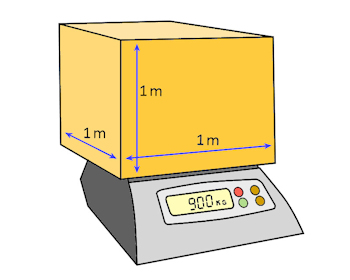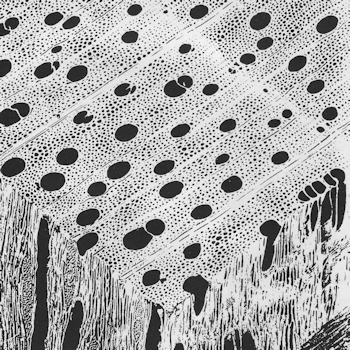Density

with nominal dimensions of 1 m x 1 m x 1 m
Density in timber is a measure of the amount of woody material that’s packed together in a given volume. As we discussed in Section 1, woody fibres are basically made up of cellulose, hemicellulose and lignin. In all species of timber this fibrous substance has a density of about 1500 kilograms per cubic metre.
However, wood cells also have cavities in them, and different species have different sized cavities and cell wall thicknesses.
So the final density of a block of wood will always be less than 1500 kg/m3, and will vary depending on how much space and other substances (such as water) are present, both inside and around the wood cells.
The drawing at right shows a block of wood measuring 1 metre x 1 metre x 1 metre (that is, one cubic metre) with a mass of 900 kilograms. This means its density is 900 kg/m3. Note that in this context, ‘mass’ is the same thing as ‘weight’ – although scientifically speaking, mass refers to the quantity of material packed into a given volume, whereas weight refers to its gravitational force as it is pulled downwards towards the earth.
Density and strength
In general, the denser a species of timber is, the stronger it is compared to other species – assuming that the pieces being compared are straight-grained and free from defects. This is because the main determining factor of strength is the thickness of the cell walls in the wood fibres.
Having said that, there are other components in wood that also contribute to its mass, including water, resins and oils – so just because a piece of wood feels heavy, that doesn’t always mean it’s also very strong.
Green density

showing thin cell walls and large cell cavities
in the trachieds (photo: CSIRO)
Green density refers to the density of wood at the time the living tree is felled. Because its weight will include a large amount of water, both in the cell walls and cell cavities, this density measurement is not a reliable indicator of the timber’s strength.
Some trees contain enormous amounts of water while they’re growing. For example, balsa is a very porous timber which can hold up to four times its own weight in water. At the other extreme are very dense species such as ironbark, which have tightly packed fibres and much less space available to hold moisture.
Green density is sometimes referred to as ‘unseasoned density’ in reference tables of wood properties, since the timber has not yet been seasoned (dried) down to normal air humidity levels.
Dry density
Dry density is sometimes called ‘seasoned density’ or ‘air dry density’ in reference tables. It refers to the timber’s density at 12% moisture content (MC), which is considered to be an average moisture content for seasoned timber.

showing large pores surrounded by fibres
with tiny cavities and much thicker cell walls (photo: CSIRO)
This allows a more direct comparison between species of the amount of woody tissue present in a given volume, since the moisture content remains constant.
The two magnified images at right show blocks of wood viewed through a microscope (reprinted with permission from the CSIRO).
You can see that there is less woody material in the oregon compared to the eucalypt, for a given volume. Therefore, its dry density will be less. Its strength will also be lower, because there is less fibrous material to provide structural support , assuming there are no other defects in the timber that would reduce its strength.
Examples of density figures
Set out below are some examples of the densities of various commercial timber species. As with all reference tables of timber densities, these figures are averages for the different species. In practice, the density of individual pieces of timber can vary greatly from the average for that species, since the actual density will depend on how fast the tree grew, where the piece was cut from the log, and other factors relating to the tree’s growing environment.
The species below are ordered from the lowest to highest dry densities. These figures are taken from the Wood Solutions website. You will also find density tables in many other reference sources, including various Australian Standards (particularly the timber grading standards) and wood technology textbooks (such as Wood in Australia, by Keith Bootle). The figures shown in different reference sources may differ slightly from each other, since they may have drawn on averages from different research studies.
| Timber species | Green density (kg/m3) | Dry density (kg/m3) |
| Western red cedar (Thuja plicata) | 490 | 350 |
| Douglas fir (Oregon) (Pseudotsuga menziesii) | 700 | 550 |
| Radiata pine (Pinus radiata) | 800 | 550 |
| Slash pine (Pinus elliottii) | 850 | 650 |
| Alpine ash (Tas. oak) (Eucalyptus delegatensis) | 1050 | 650 |
| White cypress (Callitris glaucophylla) | 850 | 700 |
| Jarrah (Eucalyptus marginata) | 1100 | 820 |
| Sydney blue gum (Eucalyptus saligna) | 1110 | 840 |
| Silvertop stringybark (Eucalyptus laevopinea) | 1050 | 850 |
| Merbau (Intsia bijuga) | 1150 | 860 |
| Brush box (Lophostemon confertus) | 1190 | 890 |
| Blackbutt (Eucalyptus pilularis) | 1100 | 900 |
| River red gum (Eucalyptus camaldulensis) | 1140 | 910 |
| Turpentine (Syncarpia glomulifera) | 1170 | 945 |
| Spotted gum (Corymbia maculata) | 1180 | 990 |
| Grey gum (Eucalyptus punctata) | 1250 | 1050 |
| Red ironbark (Eucalyptus sideroxylon) | 1160 | 1050 |